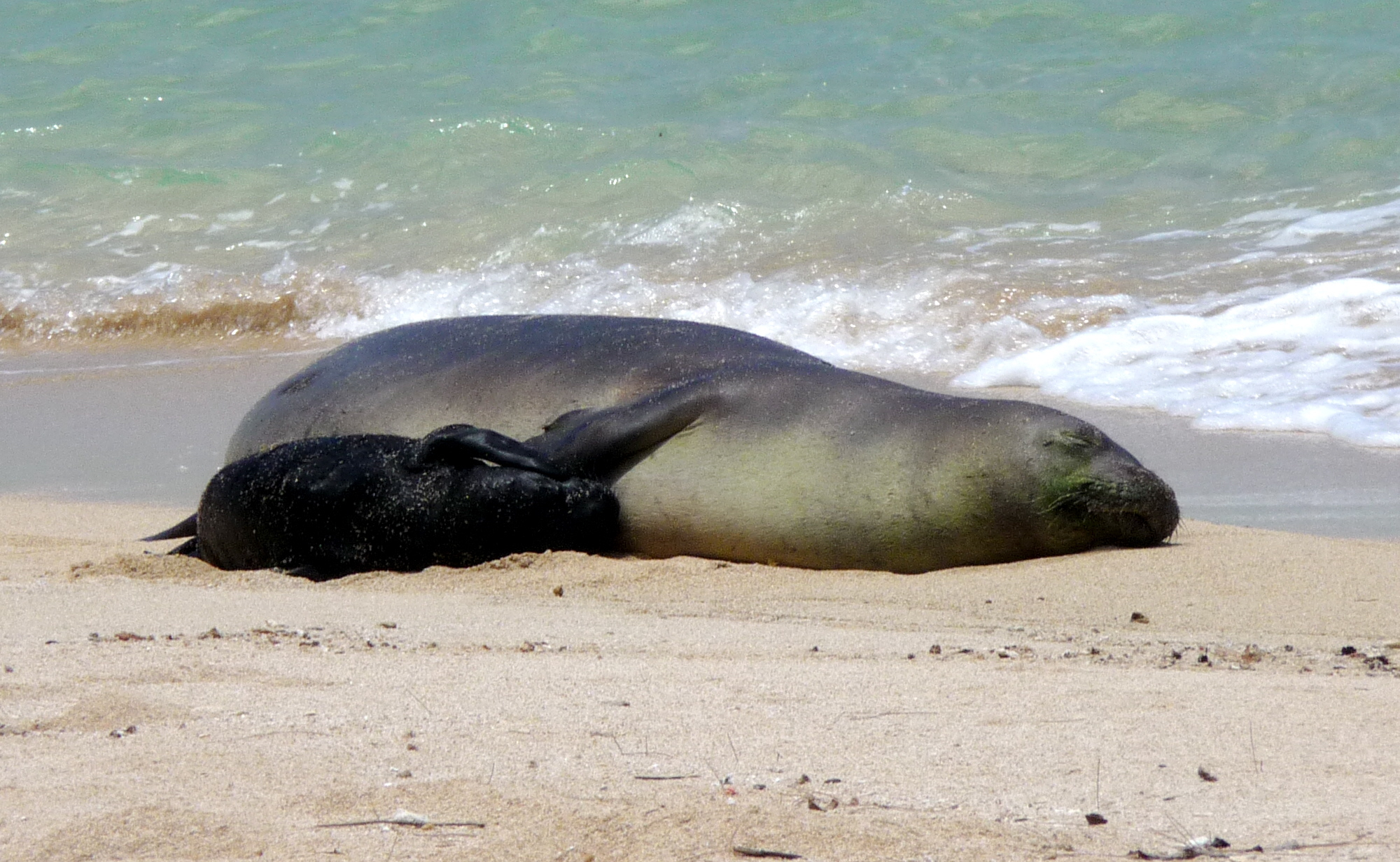Published in the Ocean Watch column, Honolulu Star-Advertiser © Susan Scott
September 14, 2009
About 10 years ago, when I lived on the North Shore, a neighbor came to my door to report a monk seal lying on a busy nearby beach.
Down to the site I went, and there found the mother of two young children instructing them to — I shudder as I write this — sit on the seal so she could get a picture.
“No!” I shouted, rushing to grab the little ones heading toward the sleeping animal. I scared the mom, the children and myself half to death, but not the seal.
It lifted its head, eyed us and went back to sleep.
The mainland woman hadn’t known Hawaiian monk seals are both endangered and dangerous. First of all, it’s illegal to approach a monk seal within 100 feet. Second, these powerful wild animals have razor-sharp teeth that could cause grave injury.
 Female Monk Seal with Pup (KC & Kolohe) Mokuleia, Oahu, 2008.
Female Monk Seal with Pup (KC & Kolohe) Mokuleia, Oahu, 2008.
After the family left and my heart climbed back in my chest, I sat on the beach, asking passers-by to give the seal a wide berth.
But I had a problem. Neither state nor federal wildlife agencies had enough workers to sit with the seal, and I couldn’t stay any longer.
Then the third miracle of the morning occurred — No. 1 being the kids weren’t hurt, and two, the seal was still there. In a remarkable act of volunteerism, another neighbor arrived with a lawn chair, umbrella and ice chest and settled down to guard the seal, which clearly needed guarding.
Monks seals are marine animals but spend about a third of their lives on land. After long foraging trips at sea hunting for fish, lobsters and other food, the seals need to rest. They also sleep on beaches during their annual energy-intensive molts, a time they shed their outer layer of fur and skin as a new layer grows beneath. Females give birth on beaches and stay there while nursing the pup.
My North Shore seal seemed accustomed to people passing by and talking. Usually, though, if someone approaches a resting seal or shouts, say, in panic that a child will be mauled, it slips back into the water, its nap time over.
Hawaiian monk seals have been declining in population for years. Not all the reasons are clear, but a few are obvious. We humans have claimed nearly all Hawaii’s beaches for ourselves, overfished island waters and lost nets that entangle and drown the seals.
Today the entire Hawaiian monk seal population is about 1,200.
Lucky for us, from 20 to 30 (they come and go) of these rare and precious individuals choose to rest mainly on Oahu.
Happily, other Hawaii residents think like my North Shore neighbor and are volunteering to help. In 2006 at Turtle Bay, volunteers helped watch over a seal mom and her pup. From that effort sprouted the Hawaiian Monk Seal Response Team Oahu, a nonprofit organization that recruits, trains and coordinates volunteers to monitor monk seals throughout Oahu. You can learn more at hmsrto.org.
To raise funds for this group, local artists have donated art for a silent auction at Chinatown’s Kim Taylor Reece Gallery at 6 p.m. Thursday. If you don’t have time to baby-sit seals, this is another way to help these native animals.
All those years ago, my Waialua neighbor sat with the seal the entire day, teaching beachgoers the rules. When I thanked him for doing that, he just shrugged.
“Someone needed to do it,” he said.
Someone still does.